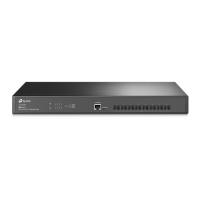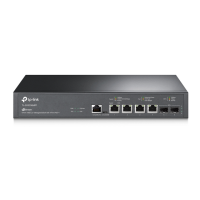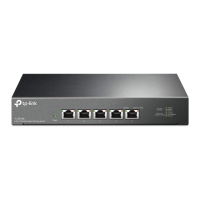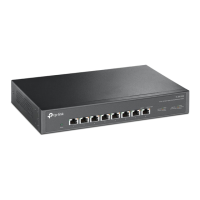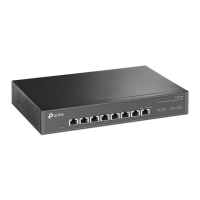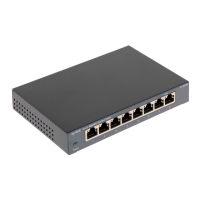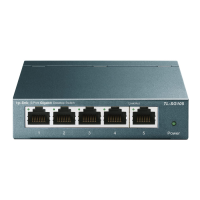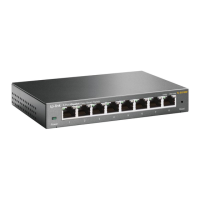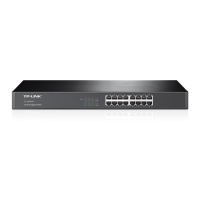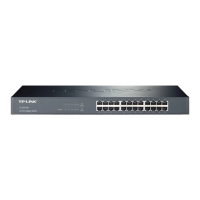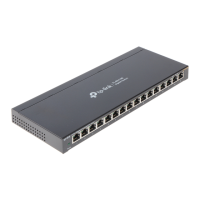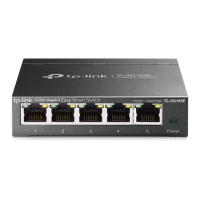Do you have a question about the TP-Link TL-SX3016F and is the answer not in the manual?
Provides a summary of the switch's features, performance, and security.
Details the front panel appearance of various switch models.
Lists the items included in the switch package for verification.
Outlines essential safety rules to prevent device damage and injury during installation.
Details measures for protecting the device from lightning strikes.
Provides step-by-step instructions for installing the device.
Describes how to connect the switch to a computer using an RJ45 cable.
Explains how to manage the switch via CLI by connecting to the console port.
Provides instructions for connecting the power cord and turning on the switch.
Describes the Power-On Self-Test process and LED indicator behavior.
Outlines the two configuration options: Standalone and Controller modes.
Details how to configure and manage the switch using GUI or CLI.
Explains how to manage devices centrally via Omada Hardware or Software Controller.
Provides steps to recover forgotten username and password using console port.
Offers troubleshooting steps for abnormal PWR/Power LED indications.
Guides on how to troubleshoot issues accessing the switch's web management page.
Provides solutions for incorrect display in terminal emulation programs.
Lists the IEEE standards supported by the switches.
Details the types of cables and their specifications for network connections.
Summarizes the LED indicators for various switch models.
Specifies the operating temperature range for different switch models.
Provides a summary of the switch's features, performance, and security.
Details the front panel appearance of various switch models.
Lists the items included in the switch package for verification.
Outlines essential safety rules to prevent device damage and injury during installation.
Details measures for protecting the device from lightning strikes.
Provides step-by-step instructions for installing the device.
Describes how to connect the switch to a computer using an RJ45 cable.
Explains how to manage the switch via CLI by connecting to the console port.
Provides instructions for connecting the power cord and turning on the switch.
Describes the Power-On Self-Test process and LED indicator behavior.
Outlines the two configuration options: Standalone and Controller modes.
Details how to configure and manage the switch using GUI or CLI.
Explains how to manage devices centrally via Omada Hardware or Software Controller.
Provides steps to recover forgotten username and password using console port.
Offers troubleshooting steps for abnormal PWR/Power LED indications.
Guides on how to troubleshoot issues accessing the switch's web management page.
Provides solutions for incorrect display in terminal emulation programs.
Lists the IEEE standards supported by the switches.
Details the types of cables and their specifications for network connections.
Summarizes the LED indicators for various switch models.
Specifies the operating temperature range for different switch models.
| Console port | RJ-45/Micro-USB |
|---|---|
| Power connector | DC-in jack |
| SFP+ module slots quantity | 16 |
| Basic switching RJ-45 Ethernet ports type | No |
| Basic switching RJ-45 Ethernet ports quantity | 0 |
| 10G support | Yes |
| Number of VLANs | 4000 |
| Networking standards | IEEE 802.1D, IEEE 802.1Q, IEEE 802.1ab, IEEE 802.1p, IEEE 802.1s, IEEE 802.1w, IEEE 802.1x, IEEE 802.3ad, IEEE 802.3x |
| Virtual LAN features | Private VLAN, Protocol-based VLAN, Tagged VLAN, Voice VLAN |
| Power source | AC |
| AC input voltage | 100 - 240 V |
| AC input frequency | 50/60 Hz |
| Power consumption (max) | 32.74 W |
| Heat dissipation | 111.71 BTU/h |
| Storage temperature (T-T) | -40 - 70 °C |
| Operating temperature (T-T) | 0 - 45 °C |
| Storage relative humidity (H-H) | 5 - 90 % |
| Operating relative humidity (H-H) | 10 - 90 % |
| Stackable | - |
| Certification | CE, FCC, RoHS |
| Product color | Black |
| Jumbo frames | 9000 |
| Forwarding rate | 238.08 Mpps |
| Number of queues | 8 |
| MAC address table | 32000 entries |
| Packet buffer memory | 24 MB |
| DHCP features | DHCP relay, DHCP server, DHCP snooping, DHCPv6 client, DHCPv6 snooping |
| Authentication | Guest VLAN, MAC-based authentication, Port-based authentication, Web-based authentication |
| Authentication type | AAA, TACACS+ |
| Security algorithms | HTTPS, SSH, SSH-2, SSL/TLS |
| Queue scheduling algorithms | SP, WRR+SP, Weighted Round Robin (WRR) |
| Switch type | Managed |
| Switch layer | L2+/L3 |
| Package type | Box |
| Package depth | 336 mm |
| Package width | 528 mm |
| Package height | 100 mm |
| Package weight | 3700 g |
| Harmonized System (HS) code | 85176990 |
| IPv4 & IPv6 features | IPv6 Telnet, IPv6 ping, IPv6 tracert |
| Depth | 220 mm |
|---|---|
| Width | 440 mm |
| Height | 44 mm |
